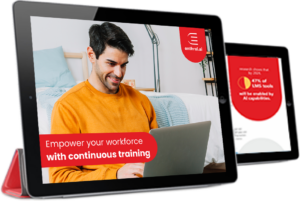How L&D can Develop a Successful Onboarding Program in 10 Easy Steps

When a new employee kicks off their journey with a company, those early days set the tone for what’s to come. They are crucial to determine the employee’s productivity and how long they will stick around.
Surprisingly, 21% employees perceive their onboarding process as ineffective or even non-existent, and a further 46% rate it only as “somewhat effective”.
For us L&D folks, this isn’t good news. Seriously, we can do better than that, can’t we?
When done correctly, onboarding not only speeds up how quickly new hires adjust, but it also boosts a company’s retention rate by a whopping 82%, as per a Glassdoor survey.
Let’s discuss this in detail.
Why is Onboarding Important?
At its core, onboarding is all about getting new hires up to speed and ready to dive into their roles smoothly. It ensures that new employees are equipped with the necessary knowledge and resources to become productive as soon as possible.
An effective onboarding process also creates a sense of belonging and teamwork from the very beginning. It plays a seminal role in nurturing employee engagement by offering a clear understanding of their job responsibilities, in turn, fueling higher levels of motivation.
Its benefits include (and almost always go beyond)
- Reduced employee turnover
- Improved productivity
- Better company reputation
- Easy communication and collaboration
- Accelerated time-to-competence
- Stronger employer brand
To cut a long story short, the future of your company depends on how quickly these newbies adapt and hit the ground running. So, it’s crystal clear that nailing down a solid onboarding program is key to organizational success.
Now as L&D, what can you do to ensure that the onboarding process is set in such a way that you can achieve its maximum advantages?

Empower your workforce with continuous training
- Employee Onboarding
- Employee Upskilling
- Compliance Training
How to Develop a Successful Onboarding Program
Step 1: Setting Realistic Expectations –
Sure, you are eager to get online training completed quickly. However, rushing through it can leave your learners feeling overwhelmed. Outcome? They’ll probably find it harder to retain information. Especially with the pressure of adjusting to a new environment and role, a rigid, high-pressure orientation isn’t going to help.
Plus, quick online courses might lack the depth needed for effective learning. Instead, establish a reasonable timeframe that allows for proper absorption and integration. Provide objectives and goals, then empower learners to set their own schedules accordingly, at their pace.
Step 2: Invest in Employee Learning Platforms
Training methods vary across companies. Some prefer hands-on learning through shadowing experienced colleagues, others expect new hires to learn on their own. The optimal approach is a blend of both. It shows trust in the new employee’s abilities while encouraging them to seek help when needed.
Learning platforms like LMS and LXP accommodate both approaches. They allow participants to learn independently while providing access to guidance when required. Evaluate different tools to find one that aligns with your requirements and budget.
Step 3: Identify Skill Gaps
When time is of the essence, it’s important to pinpoint very specific areas for improvement. Conduct assessments and surveys to identify individual training needs and tailor onboarding accordingly.
Encourage new hires to communicate areas they wish to enhance, then you can offer your suggestions.
Step 4: Draft a Training Plan
Start off by creating an exhaustive list of the skills and knowledge you want your learners to acquire. Each topic can then be assessed individually to determine its importance in the onboarding process, especially considering time constraints.
Some topics may be better suited for advanced training. Or what initially seemed urgent may no longer be, once examined closely. Hence, creating a proper plan helps in structuring the online training effectively. It enables you to determine which topics can be condensed and which require detailed coverage.
Step 5: Synthesize
This step isn’t solely about shortening lessons, although that’s important in onboarding. It is more about creating concise overviews of online training topics. Use aids like infographics or slide decks to highlight key areas within each topic.
This turns intense training content into a light and engaging presentation. You can also incorporate icons, images and metaphors to enhance retention. The goal isn’t to memorize information but to provide a teaser so that when learners go deep into the topic, it feels familiar. These summaries also serve as handy tools for refreshers.
Step 6: Mix and Match Media
For some learners, listening to something helps more than reading it. For some, it’s the opposite. To accommodate diverse learning styles, offer online training content in various formats.
While the foundation remains text and visuals, offer the same lesson through video or audio. It is not necessary to replicate the entire lesson in each format. Use videos for practical demonstrations and record audio for text passages. This will allow learners to listen while they work.
Step 7: Expand Your Just-in-Time (JIT) Resources
In any role, there are moments when new hires require quick guidance. When such situations arise, offer readily accessible how-to guides. Ensure your JIT library is user-friendly and easily searchable. This will allow people to locate the appropriate module with minimal effort.
Your online training library should cover a wide range of topics, from basic skills to more complex tasks. Such a JIT library will facilitate faster assimilation into the role.
Step 8: Personalize Training Paths
Every employee is unique with their own aspirations that are evident even at the hiring stage. As you assess their suitability for the role, you will have a better overview of this.
You can then compile information on each candidate as you consider their long-term career path. Once hired, communicate your insights and collaborate with them to create a career progression chart outlining potential roles and necessary qualifications. This shows your commitment to their development and your investment in their growth. Providing a personalized training plan with support resources and skill-bridging activities makes new employees feel valued.
Step 9: Flexibility
For onboarding training to truly succeed, flexibility is an imperative. Flexibility is particularly essential in the LMS or LXP that you are using for onboarding, as it shapes the entire experience for new hires. This means ensuring onboarding courses are consistent and accessible on all mobile devices. Flexible training offers several benefits, the most notable being increased effectiveness.
In today’s mobile-centric world, a mobile LMS/LXP is the ideal choice, catering to the needs of a mobile workforce. For instance, if you are looking to onboard a new sales team member (most likely to be on-field), an app-based learning platform can save time while providing flexible learning opportunities. This can ensure continuous access to essential organizational, product and process knowledge.
Step 10: Continuous Support and Feedback
Personalized feedback plays a huge role in the onboarding journey. It is essential to provide follow-up online training resources to help continuous skill enhancement.
Besides, assigning a seasoned peer coach or mentor can go a long way towards offering one-on-one guidance. This can also help new hires stay focused on their development goals. While time may be limited, it is important to allocate space in the onboarding schedule for continuous support and guidance.
Parting Thoughts
A well conducted online onboarding process saves time which especially helps with job roles that need quick learning.
A key to good onboarding is to invest in robust training tools and learning platforms like LMS and LXP. They contribute greatly in making the onboarding experience engaging and learning-centric for new employees.











